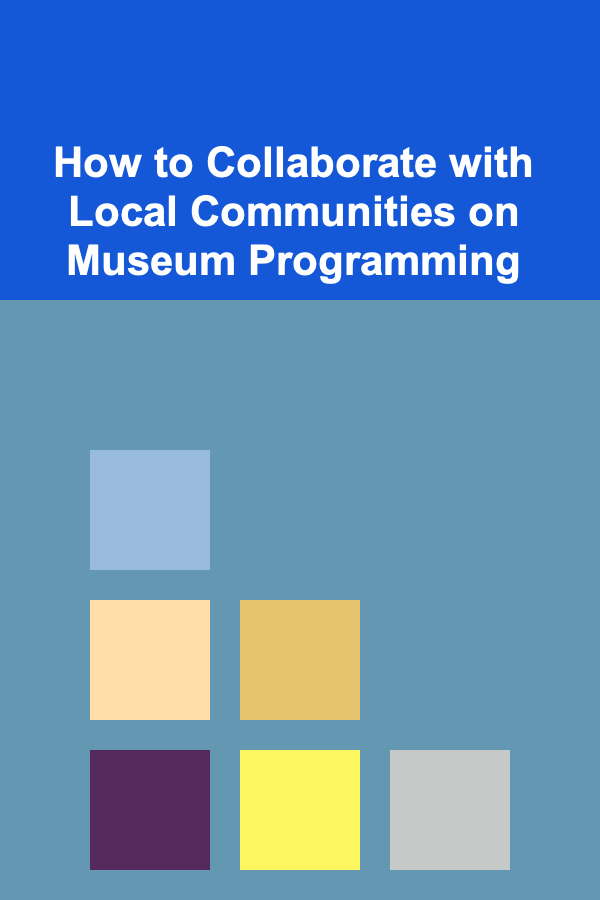
How to Collaborate with Local Communities on Museum Programming
ebook include PDF & Audio bundle (Micro Guide)
$12.99$7.99
Limited Time Offer! Order within the next:

Collaborating with local communities on museum programming is essential to creating relevant, engaging, and inclusive cultural experiences. In a world where museums are constantly evolving to attract diverse audiences, working with local communities ensures that exhibitions and events are not only reflective of the broader cultural landscape but also resonate deeply with the specific needs, histories, and perspectives of the local population. In this article, we will explore how museums can build meaningful collaborations with local communities, the benefits of such partnerships, and the steps involved in designing and implementing successful community-driven programs.
Understanding the Importance of Community Collaboration
Community engagement in museum programming is crucial because it fosters inclusivity, enriches the content of exhibitions, and broadens the museum's impact. When local communities are involved, museums can create authentic and relevant experiences that resonate on a personal level with visitors. Museums are not just spaces to house artifacts; they are platforms for storytelling, identity, and conversation. Collaborating with local communities provides an opportunity to tell stories that may otherwise be overlooked and to highlight the diversity of voices that contribute to the collective narrative.
Benefits of Collaboration with Local Communities
- Increased Relevance: Museums become more relevant when they reflect the interests, values, and concerns of the local population. Community involvement helps shape programming that is aligned with the social, cultural, and historical context of the area.
- Diverse Perspectives: Working with local communities allows museums to present a more diverse range of perspectives. Community members often have valuable insights into cultural traditions, local history, and contemporary issues that can deepen the narrative of museum exhibitions.
- Fostering Relationships: Collaborating with local communities builds strong relationships between museums and their audiences. It encourages trust, engagement, and a sense of ownership over the cultural space, which can increase attendance and participation in museum activities.
- Empowerment and Representation: By involving community members in programming, museums provide a platform for marginalized or underrepresented groups to tell their own stories. This promotes social justice and ensures a more balanced representation of different cultures and histories.
- Sustainability: Long-term collaboration with local communities fosters sustainable programming by making museums a vital part of local life. Community partnerships can help secure funding, create repeat visitors, and establish long-term relationships with local organizations and schools.
Steps to Effective Collaboration with Local Communities
Successful community collaboration in museum programming requires thoughtful planning, open communication, and respect for the community's values and needs. Below are key steps that museums can follow to create meaningful partnerships with local communities:
1. Build Relationships with Community Leaders and Organizations
Before embarking on collaborative projects, it is essential to establish strong relationships with local community leaders, organizations, and cultural institutions. These are the individuals and groups who understand the needs and concerns of the local population and can act as bridges between the museum and the community.
- Identify Key Stakeholders: Begin by identifying local community leaders, cultural organizations, schools, and non-profits that share an interest in arts, culture, and heritage. These stakeholders can provide valuable input on what kinds of programming will resonate with the local population.
- Develop Trust: Trust is the foundation of successful collaboration. Take the time to meet with local groups, listen to their perspectives, and demonstrate genuine interest in their ideas. Show that the museum values their input and sees them as equal partners in the process.
- Create Advisory Committees: Consider forming advisory committees made up of community members, cultural advocates, and local organizations. These committees can help guide the direction of community-driven programming and ensure that museum offerings are aligned with local interests and needs.
2. Conduct Community Needs Assessments
Understanding the needs, interests, and concerns of the local community is critical to designing programming that will be well received. Museums can use a variety of methods to conduct needs assessments:
- Surveys and Interviews: Reach out to community members through surveys, interviews, or focus groups to gather input about what kinds of exhibitions, events, or educational programs they would like to see at the museum.
- Community Forums and Town Halls: Host public forums or town hall meetings where community members can share their thoughts and ideas. These forums also provide a space for people to ask questions, engage in dialogue, and express their expectations for the museum.
- Collaborate with Local Schools and Universities: Educational institutions are often deeply embedded in the community and can provide insights into local culture and youth interests. Partnering with schools can also help museums create programming tailored to younger audiences.
By engaging directly with the community, museums can ensure that their programming reflects the desires and priorities of the people they serve.
3. Co-Create Programs with the Community
The best way to ensure that a program is culturally relevant and well-received is to involve the community in the co-creation process. This collaborative approach allows community members to take ownership of the museum programming and ensures that the offerings are aligned with their values and aspirations.
- Collaborative Exhibit Design: When designing an exhibition, work with community members to incorporate their perspectives, knowledge, and stories. This could involve inviting local artists, historians, or cultural practitioners to contribute content or provide guidance on how to best represent their culture.
- Interactive Workshops and Events: Host workshops where local community members can actively participate in the creation of museum content. For example, workshops on traditional crafts, storytelling, or oral history can serve as both educational experiences for visitors and an opportunity for community members to share their skills and knowledge.
- Local Artist Involvement: Collaborate with local artists to create art installations, performances, or other creative contributions to museum programming. This fosters a sense of pride and ownership among the local creative community and ensures that the museum reflects local culture in an authentic and meaningful way.
4. Offer Diverse Educational Opportunities
Museums should consider how they can use their educational resources to benefit the local community. Providing diverse learning opportunities can engage people of all ages and backgrounds and deepen their connection to the museum.
- Educational Outreach Programs: Develop outreach programs that bring museum educators into local schools, libraries, and community centers. This can help spark interest in museum exhibitions and create educational pipelines for future visitors.
- Inclusive Workshops: Offer workshops that cater to a wide range of interests and age groups. For instance, family-oriented workshops, senior citizen art classes, or career-building workshops for young adults can engage diverse segments of the community.
- Language Accessibility: Ensure that educational materials, signage, and programming are accessible to non-English speaking communities. This might involve providing translations or offering bilingual programs to reach a wider audience.
By making education a central component of community programming, museums can ensure that they remain relevant to the local population and provide lasting value to individuals of all ages.
5. Promote Inclusivity and Diversity
One of the most important aspects of community collaboration is ensuring that all voices are heard and represented. It is vital to engage with communities that are historically underrepresented or marginalized in mainstream cultural institutions. This ensures that museum programming reflects the full range of local experiences and is accessible to all.
- Reach Out to Marginalized Groups: Actively engage with marginalized or underserved communities, such as immigrant populations, communities of color, LGBTQ+ groups, and people with disabilities. Ensure that their histories, cultures, and contributions are represented in exhibitions and programs.
- Inclusive Programming: Design programs that cater to diverse audiences, including people from different socioeconomic backgrounds, races, ethnicities, and abilities. For example, consider hosting sensory-friendly exhibitions for individuals with disabilities or offering financial assistance for low-income families to attend programs.
- Community-Led Leadership: Empower community members to take on leadership roles in the museum's programming. This could involve inviting community leaders to serve as curators or guest speakers, or giving local residents the opportunity to lead tours or workshops.
Case Studies of Successful Museum-Community Collaborations
Example 1: The Smithsonian Folklife Festival
The Smithsonian Folklife Festival is a prime example of community collaboration in museum programming. Every year, the festival brings together community members, artisans, and cultural groups to celebrate and share their traditions with the public. The festival is rooted in the idea of cultural exchange and has a longstanding tradition of highlighting diverse cultures and communities.
Through its collaborative approach, the Smithsonian Folklife Festival has become an important platform for local communities to showcase their cultural heritage, and it serves as a model for other museums seeking to engage with community-driven programming.
Example 2: The National Museum of African American History and Culture
The National Museum of African American History and Culture (NMAAHC) in Washington, D.C., was built with strong community involvement. The museum worked closely with African American communities across the country to ensure that the museum's exhibits were representative of their lived experiences. The museum's opening was accompanied by a series of community-based programs that allowed individuals to share their stories and contribute artifacts to the museum's collections.
Conclusion
Collaborating with local communities on museum programming is a powerful way to ensure that museums remain relevant, inclusive, and engaged with the people they serve. By building relationships, conducting needs assessments, co-creating content, offering educational opportunities, and promoting inclusivity, museums can forge meaningful partnerships with their local communities. These collaborations not only enhance the museum's impact but also create a more enriching, diverse, and socially responsible cultural landscape. When museums work with local communities, they create spaces where all voices can be heard and celebrated.
Reading More From Our Other Websites
- [Personal Investment 101] How to Make Money with Deep Learning by Building AI Solutions
- [Digital Decluttering Tip 101] Security First: Best Practices for Protecting and Backing Up Digital Files
- [Home Soundproofing 101] How to Reduce Sound Leaks Around Electrical Outlets and Switches
- [Organization Tip 101] How to Create a Functional Laundry Room Setup
- [Home Budget 101] How to Save Money on Home Maintenance
- [Screen Printing Tip 101] DIY Stencil Materials: Which Ones Work Best for Different Ink Types?
- [Home Renovating 101] How to Rent a Dumpster for Your Renovation Project: Sizes, Costs, and Placement Tips
- [Personal Investment 101] How to Start Investing in Cryptocurrencies Safely
- [Digital Decluttering Tip 101] From Chaos to Curated: Step-by-Step Strategies to Declutter Your Photo Collection
- [Home Party Planning 101] How to Use Color Schemes to Enhance Your Party Theme

How to Create a Simple Yet Effective Cleaning Caddy
Read More
How to Cultivate a Minimalist Mindset in Everyday Life
Read More
How to Label Your Essential Oil Bottles for Easy Identification
Read More
How to Use Floor Lamps to Add Style and Functionality
Read More
The Advertising Manager's Toolkit: Techniques for Effective Campaign Execution
Read More
10 Tips for a Study Schedule Planner That Prioritizes Wellbeing
Read MoreOther Products

How to Create a Simple Yet Effective Cleaning Caddy
Read More
How to Cultivate a Minimalist Mindset in Everyday Life
Read More
How to Label Your Essential Oil Bottles for Easy Identification
Read More
How to Use Floor Lamps to Add Style and Functionality
Read More
The Advertising Manager's Toolkit: Techniques for Effective Campaign Execution
Read More